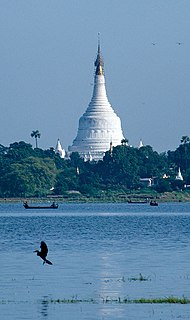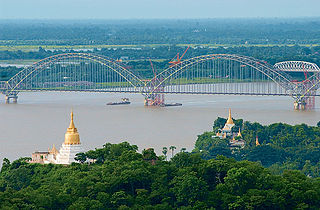
Amarapura is a former capital of Myanmar, and now a township of Mandalay city. Amarapura is bounded by the Irrawaddy river in the west, Chanmyathazi Township in the north, and the ancient capital site of Ava (Inwa) in the south. It was the capital of Myanmar twice during the Konbaung period before finally being supplanted by Mandalay 11 km north in 1859. It is historically referred to as Taungmyo in relation to Mandalay. Amarapura today is part of Mandalay, as a result of urban sprawl. The township is known today for its traditional silk and cotton weaving, and bronze casting. It is a popular tourist day-trip destination from Mandalay.

The Toungoo dynasty was the ruling dynasty of Burma (Myanmar) from the mid-16th century to 1752. Its early kings Tabinshwehti and Bayinnaung succeeded in reunifying the territories of the Pagan Kingdom for the first time since 1287 and in incorporating the Shan States for the first time. At its peak, the First Toungoo Empire also included Manipur, Chinese Shan States, Siam and Lan Xang. But the largest empire in the history of Southeast Asia collapsed in the 18 years following Bayinnaung's death in 1581.

Thihathu of Ava was king of Ava from 1421 to 1425. It was during his reign that the Forty Years' War (1385–1424) between Ava and Hanthawaddy Pegu kingdoms came to a formal close. Unlike his late elder brother Minye Kyawswa, he did not consider Pegu his enemy, and followed a policy of conciliation and friendship toward Pegu. In 1423, he actually helped to broker a truce between two rival claimants to the Hanthawaddy throne. For his help in breaking up the fight, Thihathu was given the rival princes' sister Lady Shin Sawbu whom he made his queen.
Mobye Narapati was the penultimate king of Ava who reigned from 1545 to 1551. The ethnically Shan king ruled as the disputed leader of the Confederation of Shan states that had ruled Ava since 1527. He ended the seven years' war with Toungoo as soon as he came to power. Throughout his six years of reign, he faced an active rebellion by Sithu Kyawhtin, who was supported by the Shan state of Mohnyin. He controlled only a rump state, east of the Irrawaddy and north of Pagan (Bagan). After he was finally driven out of Ava (Inwa) in October 1551, he fled south to Pegu (Bago) where he was given protection by King Bayinnaung of Toungoo Dynasty. He lived out his years at Pegu.

Shingon is one of 37 nats in the official Burmese pantheon of nats. She was a maid of King Thihathu of Ava and accompanied him to the battlefront. She died on her return to the capital, Ava.
Sanda Dewi was one of the three principal queens of King Bayinnaung of Burma from 1553 to 1581. She was also a queen of the last two kings of Prome Kingdom from 1532 to 1542. She was the maternal grandmother of Natshinnaung, king of Toungoo.
Inwa Yazawin is a lost Burmese chronicle that covers the history of the Ava Kingdom. The chronicle's existence was first mentioned in an early 15th-century chronicle called Yazawin Kyaw that did survive. At least some portions survived down to the 1720s as they were referenced in Maha Yazawin, the official chronicle of Toungoo Dynasty.

The Bagaya Monastery, located in Inwa, Mandalay Region, Burma (Myanmar) is a Buddhist monastery built on the southwest of Inwa Palace. This magnificent monastery is also known as Maha Waiyan Bontha Bagaya Monastery. During King Hsinbyushin's reign (1763–1776), Maha Thiri Zeya Thinkhaya, town officer of Magwe built the monastery in the Bagaya monastic establishment and dedicated to Shin Dhammabhinanda. It is one of the famous tourists attractions in Burma.

The Irrawaddy Bridge (Yadanabon) is a bridge in Mandalay, Myanmar. It crosses the Irrawaddy River, to the southwest of Mandalay and Amarapura and just to the north of the old Ava Bridge, and is also known as the New Ava Bridge. It was completed in 2008.

Minkhaung I of Toungoo was viceroy of Toungoo from 1446 to 1451. Having accidentally inherited the Toungoo throne after his father's sudden death, Minkhaung proved an ineffectual ruler of this perpetually unruly frontier vassal state of Ava Kingdom. He was assassinated in 1451 by a servant of his first cousin Minye Kyawhtin, who went on to seize Toungoo in his rebellion against King Narapati I of Ava. All royal chronicles starting with the Maha Yazawin chronicle, identify Minkhaung I of Toungoo as an ancestor of King Bayinnaung of Toungoo Dynasty.
Min Letya was governor of Ava (Inwa) from 1584 to 1586 during the reign of King Nanda of Toungoo Dynasty of Burma (Myanmar). Min Letya was the only son of King Tabinshwehti mentioned in the Burmese chronicles.
Inwa Mibaya was the chief queen consort of Ava from 1555 to 1584. She was the eldest child of King Bayinnaung and his chief queen Atula Thiri Maha Yaza Dewi of Toungoo Dynasty of Burma (Myanmar). At age 20, she was married off to Bayinnaung's younger half-brother Thado Minsaw, at the latter's coronation ceremony as viceroy of Ava on 19 February 1555. The couple had a daughter, Natshin Medaw.
Min Taya Medaw was a principal queen of King Nanda of Toungoo Dynasty of Burma (Myanmar) from 1581 to 1599. Nanda was her first cousin. The queen was described in a well-known eigyin-style poem/song by the famous poet Nawaday, who served at the Prome court. She and the king had no children.
Natshin Medaw was crown princess of Toungoo Dynasty of Burma (Myanmar) from 1581 to 1586.
Atula Thiri Maha Yaza Dewi of Ava was the chief queen consort of King Narapati I of Ava from 1442 to 1468. She was the mother of King Thihathura of Ava and King Thado Minsaw of Prome, and a maternal aunt of King Leik Munhtaw of Hanthawaddy. King Alaungpaya, the founder of Konbaung Dynasty, was a tenth generation descendant of the queen.
Saw Beza was a queen consort of King Swa Saw Ke of Ava. She was the mother of King Minkhaung I of Ava, Gov. Theiddat of Sagaing, and Queen Thupaba Dewi of Hanthawaddy Pegu.
Soe Min Hteik-Tin was the chief queen consort of Toungoo from 1510 to 1530. Her reign title was Thiri Atula Maha Nanda Dewi. She was a daughter of Viceroy Min Sithu of Toungoo. In 1485, her first cousin Mingyi Nyo assassinated her father because he had refused give her in marriage to Nyo. She became the chief queen consort in 1510 when Nyo declared independence from Ava (Inwa). On 11 April 1511, at the coronation ceremony, she was crowned the chief queen with the title Thiri Atula Maha Nanda Dewi ).
Thihapate of Tagaung was governor of Tagaung from 1367 to 1400. The powerful governor of the northernmost vassal state of Ava was a brother-in-law of King Swa Saw Ke, and had even served as a tutor to Crown Prince Tarabya. In 1380/81, he was even considered by King Swa Saw Ke as a candidate to become king of Arakan although he was ultimately passed over.









